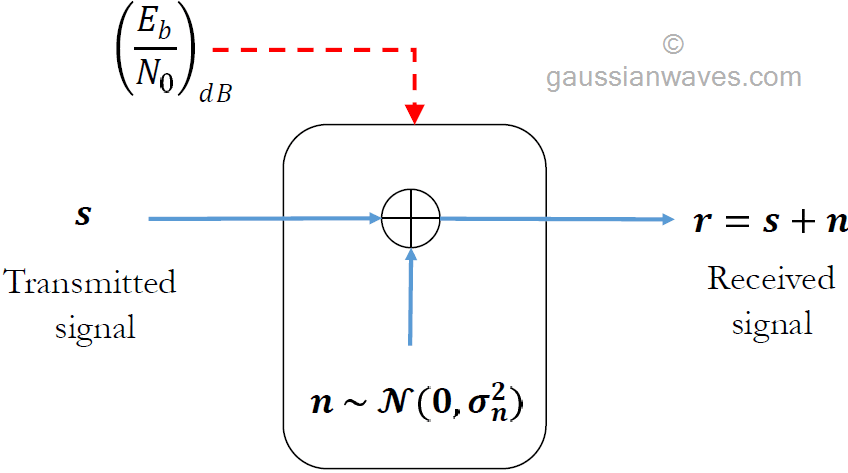1. Add white Gaussian noise to signal - MATLAB awgn
Berawgn
This MATLAB function adds white Gaussian noise to the vector signal X.
2. AWGN Channel - MATLAB & Simulink
An AWGN channel adds white Gaussian noise to the signal that passes through it. You can create an AWGN channel in a model using the comm.AWGNChannel System ...
Model channel and RF impairment characteristics.
3. Add white Gaussian noise to input signal - MATLAB - MathWorks
AWGNChannel creates an additive white Gaussian noise (AWGN) channel System object™, awgnchan . This object then adds white Gaussian noise to a real or complex ...
comm.AWGNChannel adds white Gaussian noise to the input signal.
4. Using awgn and snr functions in matlab - MathWorks
Aug 28, 2019 · In matlab, I create a sawtooth signal, add noise to it using 'awgn' function, and then measure the SNR using 'snr' function.
In matlab, I create a sawtooth signal, add noise to it using 'awgn' function, and then measure the SNR using 'snr' function. x = sawtooth(0:0.1:10); y = awgn(x,10,'measured'); SNR = snr(y,y-x); ...

5. Add white Gaussian noise to input signal - Simulink - MathWorks
Description. The AWGN Channel block adds white Gaussian noise to the input signal. It inherits the sample time from the input signal. Examples.
The AWGN Channel block adds white Gaussian noise to the input signal.
6. How to add White Gaussian Noise to Signal using MATLAB
Aug 16, 2021 · The white Gaussian noise can be added to the signals using MATLAB/GNU-Octave inbuilt function awgn(). Here, “AWGN” stands for “Additive White ...
A Computer Science portal for geeks. It contains well written, well thought and well explained computer science and programming articles, quizzes and practice/competitive programming/company interview Questions.

7. Difference between randn() and awgn() in adding white noise to a ...
Oct 25, 2020 · I'm trying to add a white noise to my signal and simulate it for different SNR values. But I'm not sure if i should use randn() or awgn(). For ...
Hi everyone I'm trying to add a white noise to my signal and simulate it for different SNR values. But I'm not sure if i should use randn() or awgn(). For instance I don't understand why these ...

8. [PDF] How to generate AWGN noise in Matlab/Octave (without using in ...
Jun 16, 2015 · The function y = awgn(x,SNR,0 measured0), first measures the power of the signal vector x and then adds white. Gaussian Noise to x for the given ...
9. HDL Implementation of AWGN Generator - MATLAB & Simulink
Implement AWGN generator that is optimized for HDL code generation and hardware implementation.
10. How awgn add white noise on complex envolope signal - MathWorks
Jan 16, 2020 · awgn(RX,SNR,'measured') adds noise to each sample of RX. If RX is a real vector, only the real component has noise added to it.
See AlsoJazmen00 MegaHello An I/Q baseband signal goes through Tx, the wave received by Rx at carrier (fc) with condisering receiver noise should be "rx_noise" noise=0.1*rand(length(t),1) rx = [I(t)*cos(2*pi*fc*t) -...

11. Add AWGN noise to signal - File Exchange - MATLAB Central
May 6, 2017 · Share 'Add AWGN noise to signal' ... This function adds additive white Gaussian noise (with zero mean and given SNR) to a signal. Signal can be ...
Function to add AWGN of given SNR to any n-D signal

12. Is noise with awgn function or randn fucntion can guarantee SNR?
Jul 12, 2022 · On the other hand, the “awgn” function in MATLAB is used to add additive white Gaussian noise (AWGN) to a signal. It allows you to specify ...
I saw 2 ways to add WGN 1st is noise_power/sqrt(2)*(randn+1j*randn) 2nd is awgn(signal,SNR,signal_power) I think these 2 method cant guarantee SNR because of random (of course awgn fucntion is ...

13. How to add White Gaussian Noise to Signal using MATLAB?
Sep 7, 2023 · Y = awgn(X, snr);. Here, X is the input signal, snr is the signal to noise ratio, and Y is the noisy signal. Example.
How to add White Gaussian Noise to Signal using MATLAB - A type of noise signal which has a flat power spectral density (PSD) across all frequencies is referred to as white gaussian noise or white noise. In this tutorial, I will explain how to add white gaussian noise to signal using MATLAB. But before that let get a brief overview of white gaussian noise

14. awgn function - how does it add signal-to-noise ratio - MATLAB Answers
Apr 21, 2015 · awgn function - how does it add signal-to-noise... Learn more about awgn, snr, statistics.
Hi, I've been using the function awgn to add white gaussian noise to some synthetic data. I need to know exactly how this is done by the function, but I can't find it in the documentation. Can a...

15. Simulate additive white Gaussian noise (AWGN) channel
Jun 15, 2015 · Simulate in Python & Matlab: additive white Gaussian noise (AWGN) channel. Plot error rate performance for digital modulations over AWGN ...
Simulate in Python & Matlab: additive white Gaussian noise (AWGN) channel. Plot error rate performance for digital modulations over AWGN channel.

16. Need help generating turbocode data with awgn noise in matlab for ...
Dec 7, 2023 · Rounding to Nearest Integer: The code is rounding the noisy data to the nearest integer to restore it to a binary format, which is a typical ...
I previously managed to figure out the generation of code without noise which worked with training of my model, but now I need to add awgn noise for further research, but am facing trouble in using...

17. How to remove the AWGN noise from data? - MATLAB Answers
Sep 29, 2022 · I would simply use a moving average filter, for example movmean, or choose one of the options in smoothdata, to eliminate normally-distributed ...
Let's say we have a vector data Uo=[20 30 40 50]; If we add AWGN noise to it, it becomes data U i.e., U=awgn(Uo,30); Now we see that U and Uo are different. We want to get back our original data...
